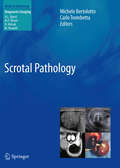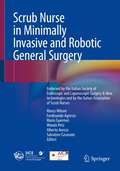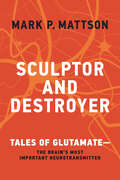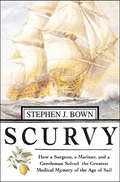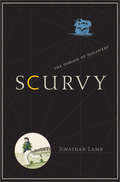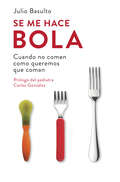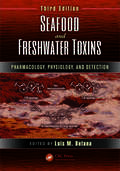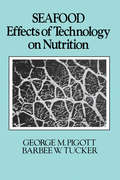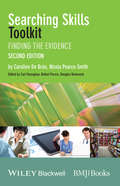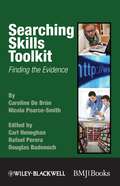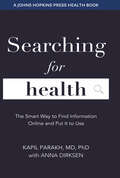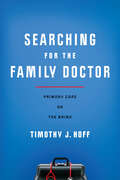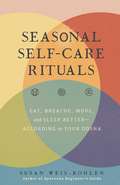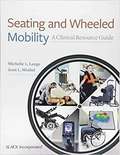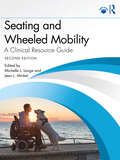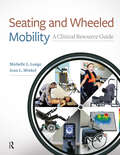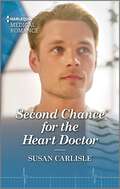- Table View
- List View
Scripting Death: Stories of Assisted Dying in America (California Series in Public Anthropology #50)
by Mara BuchbinderHow the legalization of assisted dying is changing our lives. Over the past five years, medical aid-in-dying (also known as assisted suicide) has expanded rapidly in the United States and is now legally available to one in five Americans. This growing social and political movement heralds the possibility of a new era of choice in dying. Yet very little is publicly known about how medical aid-in-dying laws affect ordinary citizens once they are put into practice. Sociological studies of new health policies have repeatedly demonstrated that the realities often fall short of advocacy visions, raising questions about how much choice and control aid-in-dying actually affords. Scripting Death chronicles two years of ethnographic research documenting the implementation of Vermont’s 2013 Patient Choice and Control at End of Life Act. Author Mara Buchbinder weaves together stories collected from patients, caregivers, health care providers, activists, and legislators to illustrate how they navigate aid-in-dying as a new medical frontier in the aftermath of legalization. Scripting Death explains how medical aid-in-dying works, what motivates people to pursue it, and ultimately, why upholding the "right to die" is very different from ensuring access to this life-ending procedure. This unprecedented, in-depth account uses the case of assisted death as an entry point into ongoing cultural conversations about the changing landscape of death and dying in the United States.
Scrotal Pathology
by Carlo Trombetta Michele BertolottoScrotal Pathology is a comprehensive practical guide to the management of patients who present with scrotal disorders. Introductory chapters consider imaging instrumentation, clinical evaluation, and clinical and imaging anatomy. The full range of disorders is then discussed in individual chapters organized according to clinical presentation. All clinical and imaging aspects are covered in depth, with full description of symptoms and explanation of the value of different clinical tests and imaging modalities. In addition, underlying histopathological features are presented and correlated with imaging features in order to clarify their pathological basis. For each disorder, therapeutic strategies are discussed and appraised. Adults and children are considered separately whenever necessary, bearing in mind that they often present essentially different scrotal pathology. The many images are all of high quality and were obtained using high-end equipment.
Scrub Nurse in Minimally Invasive and Robotic General Surgery: Endorsed by the Italian Society of Endoscopic and Laparoscopic Surgery & New technologies and by the Italian Association of Scrub Nurses
by Ferdinando Agresta Marco Milone Mario Guerrieri Wanda Petz Alberto Arezzo Salvatore CasaranoThis comprehensive book provides an excellent overview on the role of the scrub and circulating nurse during minimally invasive procedures and a detailed description of the specific instruments adopted during surgical procedures in each subspecialty areas as esophago-gastric, colorectal, endocrino-metabolic, hepato-biliary, spleno-pancreatic and abdominal wall surgery. The concept that laparoscopy now allows everyone to actively see all the surgical steps and therefore to be no longer just a simple “another man/woman in the theatre” but an active actor. The need therefore for all the nurses – and above all the scrub ones - to know and to have the knowledge - and therefore to have in a sort of parallelism thanks to this manual - the purely medical surgical steps with the corresponding and parallel nursing ones: an added value in the training and preparation of the all the people involved in surgery. This practical book correlated by images guides scrub nurse in all operative phases. The Scrub Nurse in Minimally Invasive and Robotic General Surgery also explores the legal aspects in the scrub nursing.The Italian Society of Endoscopic and Laparoscopic Surgery & New technologies and the Italian Association of Scrub Nurses endorse this book.
Sculptor and Destroyer: Tales of Glutamatethe Brain's Most Important Neurotransmitter
by Mark P. MattsonThe fascinating story of glutamate, the neurotransmitter that controls the structure and function of the brain in health and neurological disorders.Sculptor and Destroyer tells the story of a simple, little-known molecule that became a master architect and commander of the human brain: glutamate. Upward of 90 percent of the neurons in the human brain deploy glutamate as their neurotransmitter. Other neurotransmitters can only exert their effects on brain function by subtly modifying the ongoing activity of glutamatergic neurons, but during brain development glutamate controls the growth of dendrites and the formation of synapses. In this eye-opening book, Mark Mattson explains how the neurotransmitter glutamate controls the structure and function of neuronal networks in the brain, thereby mediating the brain&’s capabilities, including learning and memory, creativity, and imagination.Mattson also delves deeply into the dark side of glutamate, which he calls the &“destroyer&” side. He shows how relatively subtle aberrancies in the activity of neurons that deploy glutamate may result in behavioral disorders ranging from autism and schizophrenia to chronic anxiety and depression. More dramatically, he describes how glutamate can excite neurons to death, a process that occurs in epilepsy and stroke and, perhaps even more insidiously, in Alzheimer&’s disease, Parkinson&’s disease, ALS, and Huntington&’s disease. Sculptor and Destroyer concludes with a perspective on how knowledge of glutamate&’s roles in neuroplasticity might be applied to the optimization of brain health throughout our lives.Written in engaging, approachable prose, Sculptor and Destroyer will be of interest to anyone in the fields of neuroscience, neurology, psychiatry, and psychology, as well as to anyone with a curiosity about the human brain.
Scurvy: How a Surgeon, a Mariner, and a Gentlemen Solved the Greatest Medical Mystery of the Age of Sail
by Stephen J. BownScurvy took a terrible toll in the Age of Sail, killing more sailors than were lost in all sea battles combined. The threat of the disease kept ships close to home and doomed those vessels that ventured too far from port. The willful ignorance of the royal medical elite, who endorsed ludicrous medical theories based on speculative research while ignoring the life-saving properties of citrus fruit, cost tens of thousands of lives and altered the course of many battles at sea. The cure for scurvy ranks among the greatest of human accomplishments, yet its impact on history has, until now, been largely ignored. From the earliest recorded appearance of the disease in the sixteenth century, to the eighteenth century, where a man had only half a chance of surviving the scourge, to the early nineteenth century, when the British conquered scurvy and successfully blockaded the French and defeated Napoleon, Scurvy is a medical detective story for the ages, the fascinating true story of how James Lind (the surgeon), James Cook (the mariner), and Gilbert Blane (the gentleman) worked separately to eliminate the dreaded affliction. Scurvy is an evocative journey back to the era of wooden ships and sails, when the disease infiltrated every aspect of seafaring life: press gangs "recruit" mariners on the way home from a late night at the pub; a terrible voyage in search of riches ends with a hobbled fleet and half the crew heaved overboard; Cook majestically travels the South Seas but suffers an unimaginable fate. Brimming with tales of ships, sailors, and baffling bureaucracy, Scurvy is a rare mix of compelling history and classic adventure story.
Scurvy: The Disease of Discovery
by Jonathan LambScurvy, a disease often associated with long stretches of maritime travel, generated sensations exceeding the standard of what was normal. Eyes dazzled, skin was morbidly sensitive, emotions veered between disgust and delight. In this book, Jonathan Lamb presents an intellectual history of scurvy unlike any other, probing the speechless encounter with powerful sensations to tell the story of the disease that its victims couldn't because they found their illness too terrible and, in some cases, too exciting.Drawing on historical accounts from scientists and voyagers as well as major literary works, Lamb traces the cultural impact of scurvy during the eighteenth-century age of geographical and scientific discovery. He explains the medical knowledge surrounding scurvy and the debates about its cause, prevention, and attempted cures. He vividly describes the phenomenon and experience of "scorbutic nostalgia," in which victims imagined mirages of food, water, or home, and then wept when such pleasures proved impossible to consume or reach. Lamb argues that a culture of scurvy arose in the colony of Australia, which was prey to the disease in its early years, and identifies a literature of scurvy in the works of such figures as Herman Melville, Samuel Taylor Coleridge, Francis Bacon, and Jonathan Swift.Masterful and illuminating, Scurvy shows how the journeys of discovery in the eighteenth century not only ventured outward to the ends of the earth, but were also an inward voyage into the realms of sensation and passion.
Se me hace bola: Cuando no comen como queremos que coman
by Julio BasultoUn enfoque diferente de la alimentación infantil para que la hora de la comida sea un momento feliz para niños y adultos. ¿Qué hacer cuando nuestro hijo come menos de lo que querríamos? ¿Debemos demorar la incorporación de alimentos potencialmente alergénicos? ¿Cómo lidiar con la atractiva y omnipresente oferta de alimentos superfluos y procesados? ¿Qué hacer para prevenir la cada vez más frecuente obesidad infantil? Utilizando una visión holística de la alimentación y analizándola desde diferentes prismas, Julio Basulto ha escrito una guía sencilla y efectiva, a la vez que científicamente documentada, para que los niños se alimenten de forma saludable. No se trata de «inculcar», «coaccionar» o «imponer», sino de incorporar dentro de casa un patrón de dieta sana para que nuestros hijos aprendan con el ejemplo. Además, este manual responde con rigor y cercanía a todas las dudas sobre alimentación que pueden tener los padres hoy en día. Una obra indispensable en el hogar de cualquier madre o padre responsable.
Sea Bean: A Beachcomber's Search for a Magical Charm—A Memoir
by Sally Huband“Sea Bean is a coastal treasure. Its hard-won attentiveness shows the wonder and vulnerability of our interconnected oceans, wildlife, and people. In Sally's writing, beachcombing—an old island pursuit—is modern, revealing and restorative. The next time I am at the shore I will have a deeper appreciation and curiosity."—Amy Liptrot, author of The Outrun and The InstantA Waterstones Nature and Travel Best Book of 2023Winner of the Highlands Book Prize 2023Longlisted for the Wainwright Nature PrizeA powerful journey of sea and self, trial and hope on the islands of Shetland, where climate change is making marked impacts on the natural world.When a seed falls from a vine in the tropics and is carried by ocean currents across the Atlantic to the shores of Western Europe, it is known as a sea bean. It’s long been lucky to find a sea bean upon the shore; these seeds have been collected and used as magical charms for more than a thousand years.Sally Huband's search for the elusive sea bean begins shortly after she moves to the windswept archipelago of Shetland, the northernmost region of Great Britain, situated between the Atlantic Ocean and the North Sea. When pregnancy triggers a chronic illness and forces her to slow down, Sally turns to the beaches for solace and wellbeing. There, she discovers treasure freighted with story and curiosities that connect her to the world.The wild shores of Shetland offer glimpses of orcas swimming through the ocean at dusk, the chance to release a tiny storm petrel into the dark of the night, and a path of hope. This beachcombing path takes her from the Faroese archipelago to the Orkney islands, and the Dutch island of Texel. It opens a world of ancient myths, fragile ecology, and deep human history. It brings her to herself again.Sea Bean is a like a message in a bottle. It reveals the interconnection of our oceans, our communities, and ourselves, and offers both comfort and an invitation to feel belonging when we are adrift.
Seafood Choices: Balancing Benefits And Risks
by Institute of Medicine of the National AcademiesThe fragmented information that consumers receive about the nutritional value and health risks associated with fish and shellfish can result in confusion or misperceptions about these food sources. Consumers are therefore confronted with a dilemma: they are told that seafood is good for them and should be consumed in large amounts, while at the same time the federal government and most states have issued advisories urging caution in the consumption of certain species or seafood from specific waters. Seafood Choices carefully explores the decision-making process for selecting seafood by assessing the evidence on availability of specific nutrients (compared to other food sources) to obtain the greatest nutritional benefits. The book prioritizes the potential for adverse health effects from both naturally occurring and introduced toxicants in seafood; assesses evidence on the availability of specific nutrients in seafood compared to other food sources; determines the impact of modifying food choices to reduce intake of toxicants on nutrient intake and nutritional status within the U.S. population; develops a decision path for U.S. consumers to weigh their seafood choices to obtain nutritional benefits balanced against exposure risks; and identifies data gaps and recommendations for future research. The information provided in this book will benefit food technologists, food manufacturers, nutritionists, and those involved in health professions making nutritional recommendations.
Seafood and Freshwater Toxins: Pharmacology, Physiology, and Detection, Third Edition
by Luis M. BotanaThe last few years have brought about many changes in the field of marine and freshwater toxins, with advances in analytical technology and the realization that these toxins are a global issue. Offering a complete reference guide, Seafood and Freshwater Toxins: Pharmacology, Physiology, and Detection, Third Edition addresses all aspects of the soci
Seafood: Effects of Technology on Nutrition (Food Science And Technology Ser. #39)
by George M. Pigott Barbara TuckerAnalyzes how the technology and commercial practices of cultivation affect the nutritive value of certain fish, molluscs, crustacea, and freshwater plants. Organized to reflect the sequence from growth, harvest, and capture, through transportation, storage, and processing, to packaging and distribut
Searching Skills Toolkit
by Caroline De Brún Nicola Pearce-SmithSearching Skills Toolkit is an expert guide to help you find the clinical evidence you need more easily and effectively.Clearly presented with useful tips and advice, flow charts, diagrams and real-life clinical scenarios, it shows the best methods for finding quality evidence. From deciding where to start, to building a search strategy, refining results and critical appraisal, it is a step-by-step guide to the process of finding healthcare evidence, and is designed for use by all health and social care professionals.This second edition has been expanded with new chapters on searching for sources to support evidence-based management decision making and how to better enable your patients to make informed choices. It has also been fully updated to include new web sources, open source reference management software, and new training resources and exercises.Searching Skills Toolkit is an ideal reference for doctors, nurses, allied health professionals, managers and decision makers, researchers and students.
Searching Skills Toolkit: Finding the Evidence (EBMT-EBM Toolkit Series #8)
by Nicola Pearce-Smith Caroline De BrúnThe distinguishing feature of this pocket-sized searching skills book, like all the Toolkit series titles, is its user-friendliness. The guiding principle is that readers do not want to become librarians, but they are faced with practical difficulties when searching for evidence, such as lack of skills, lack of time and information overload. They need to learn simple search skills, and be directed towards the right resources to find the best evidence to support their decision-making. A user-friendly, Hands-On guide to literature searching, which is an essential skill for all involved in health care research and development, researchers, and students from all disciplines.
Searching for Health: The Smart Way to Find Information Online and Put It to Use (A Johns Hopkins Press Health Book)
by Kapil Parakh Anna DirksenAn insider's guide to searching online, communicating with your physician, and maximizing your health from a doctor who works at Google.We've all been there. Late at night, staring into the glow of a phone trying to make sense of some health-related issue that we know nothing about. In Searching for Health, Dr. Kapil Parakh, with Anna Dirksen, brings to life knowledge he gained from working at Google and practicing medicine. Helping readers avoid common pitfalls, get the information they need, and partner effectively with their health team to figure out a path to good health together, the book distills decades of scientific research into a set of easy-to-follow tips. It also incorporates • firsthand accounts of common challenges on the path to good health;• an inside look at how doctors approach and assess health-related information;• techniques that consumers can use to locate evidence-based information online, whether in blogs, social media postings, forums, or news stories;• guidance on how individuals can make the best use of new technologies, such as health trackers and other applications;• recommendations to help patients assess health information for themselves and make decisions based on what they find;• brief summaries of the scientific studies underpinning the recommendations; and • online and offline resources—including handy checklists and worksheets—to help readers prepare for appointments, discuss tough topics with their doctors, and take control of their health.In addition to helping readers find evidence-based information online, the book provides insights into what you can expect from a visit to a doctor or hospital, how to make a decision about surgery or other treatment, what tests doctors will order, which symptom trackers are really effective, and what questions to ask about medications, supplements, and more. Searching for Health is a valuable resource for charting a healthier path through life.
Searching for the Family Doctor: Primary Care on the Brink
by Timothy J. HoffWith family doctors increasingly overburdened, bureaucratized, and burned out, how can the field change before it's too late?Over the past few decades, as American medical practice has become increasingly specialized, the number of generalists—doctors who care for the whole person—has plummeted. On paper, family medicine sounds noble; in practice, though, the field is so demanding in scope and substance, and the health system so favorable to specialists, that it cannot be fulfilled by most doctors.In Searching for the Family Doctor, Timothy J. Hoff weaves together the early history of the family practice specialty in the United States with the personal narratives of modern-day family doctors. By formalizing this area of practice and instituting specialist-level training requirements, the originators of family practice hoped to increase respect for generalists, improve the pipeline of young medical graduates choosing primary care, and, in so doing, have a major positive impact on the way patients receive care. Drawing on in-depth interviews with fifty-five family doctors, Hoff shows us how these medical professionals have had their calling transformed not only by the indifferent acts of an unsupportive health care system but by the hand of their own medical specialty—a specialty that has chosen to pursue short- over long-term viability, conformity over uniqueness, and protectionism over collaboration. A specialty unable to innovate to keep its membership cohesive and focused on fulfilling the generalist ideal. The family doctor, Hoff explains, was conceived of as a powered-up version of the "country doctor" idea. At a time when doctor-patient relationships are evaporating in the face of highly transactional, fast-food-style medical practice, this ideal seems both nostalgic and revolutionary. However, the realities of highly bureaucratic reimbursement and quality-of-care requirements, educational debt, and ongoing consolidation of the old-fashioned independent doctor's office into corporate health systems have stacked the deck against the altruists and true believers who are drawn to the profession of family practice. As more family doctors wind up working for big health care corporations, their career paths grow more parochial, balkanizing the specialty. Their work roles and professional identities are increasingly niche-oriented. Exploring how to save primary care by giving family doctors a fighting chance to become the generalists we need in our lives, Searching for the Family Doctor is required reading for anyone interested in the troubled state of modern medicine.
Season to Taste: How I Lost My Sense of Smell and Found My Way
by Molly Birnbaum“A rich, engrossing, and deeply intelligent story….This is a book I won’t soon forget.”—Molly Wizenberg, bestselling author of A Homemade Life“Fresh, smart, and consistently surprising. If this beautifully written book were a smell, it would be a crisp green apple.”—Claire Dederer, bestselling author of PoserSeason to Taste is an aspiring chef’s moving account of finding her way—in the kitchen and beyond—after a tragic accident destroys her sense of smell. Molly Birnbaum’s remarkable story—written with the good cheer and great charm of popular food writers Laurie Colwin and Ruth Reichl—is destined to stand alongside Julie Powell’s Julie and Julia as a classic tale of a cooking life. Season to Taste is sad, funny, joyous, and inspiring.
Seasonal Self-Care Rituals: Eat, Breathe, Move, and Sleep Better—According to Your Dosha
by Susan Weis-BohlenReap the health benefits of Ayurveda and optimize your seasonal habits with powerful, personalized self-care rituals to achieve permanent weight loss, increased focus, and emotional wellness.According to the ancient texts of Ayurveda, &“All diseases begin at the junctions of the seasons.&” When we push against the essence of each season—staying up late in the winter, eating sweet, heavy foods in the spring, or neglecting our skin in the summer—we fall out of sync with nature and optimal health. Drawing on more than a decade of experience, Chopra-certified teacher Susan Weis-Bohlen guides readers through simple yet profoundly effective, dosha-specific remedies and rituals—including food & drink, meditation, yoga, essential oils, chakra alignment, mantra, and breath work—to support your ideal body weight, increased focus and mental clarity, a healthier microbiome, improved stamina, better sleep, and emotional wellness. Featuring an all-new new dosha quiz measuring both mind and body constitution—Seasonal Self-Care Rituals is an essential guide to year-round health.
Seating And Wheeled Mobility: A Clinical Resource Guide
by Michelle L. Lange Jean MinkelSeating and Wheeled Mobility: A Clinical Resource Guide presents clinical assessment considerations when working with a person with a disability who may need wheelchair seating for postural support, skin integrity, or a wheelchair base to best meet dependent or independent mobility needs. <p><p> Michelle L. Lange and Jean Minkel have designed this text to support occupational and physical therapists, complex rehabilitation technology suppliers, and even third-party payers who are interested in wheelchair seating and mobility assessment and applications. Seating and Wheeled Mobility provides a wide spectrum of information from foundational information for those practitioners who are new to the field to in-depth, population-specific information for practitioners who perhaps have not worked with a particular population in the past. <p> Seating and Wheeled Mobility: A Clinical Resource Guide provides the depth and breadth of the clinical practice of wheelchair seating and mobility to both those who are new to the field, as well as seasoned professionals.
Seating and Wheeled Mobility: A Clinical Resource Guide
by Michelle L. Lange Jean L. MinkelFully updated and expanded in its second edition, Seating and Wheeled Mobility: A Clinical Resource Guide presents clinical assessment considerations when working with a person with a mobility disability.The book provides a wide spectrum of information, from foundational information for those practitioners who are new to the field, to in-depth, population-specific information for practitioners who perhaps have not worked with a particular population in the past.The book is divided into sections, each section addressing a different area of clinical practice in wheelchair seating and mobility. The first section is an in-depth presentation of the assessment process and pressure management. The range of available seating supports is presented as part of the product selection process, including matching the person’s needs with available technology. The second section focuses on 24-hour postural care. Three types of sitters are presented: hands-free, hands-dependent, and prop sitters. Included is the most current method to measure and describe the seated person and related support surfaces needed when recommending a device. The third section lays the foundation for clinical decision making around the selection and fit of the most appropriate wheeled mobility device – manual/power wheelchair or scooter. The fourth section provides in-depth clinical applications for each mobility category. On-time mobility for the very young, power seating, and mobility skills training are addressed. The fifth section provides population specific clinical application of position, pressure management, and mobility for the pediatric, geriatric, and bariatric populations, as well as persons with both degenerative and complex neuromuscular impairments. The sixth section presents additional considerations when working with persons who are aging with a disability, considerations of the environment of use, safe transport of a wheelchair, and the application of wheelchair standards in the clinic. Finally, measuring outcomes throughout the service provision process and a look at the past, present, and future of complex rehab technology is included. Richly illustrated throughout, this book has been carefully designed to support occupational and physical therapists, suppliers/distributors, and funders/payers who are interested in wheelchair seating and mobility assessment and applications.
Seating and Wheeled Mobility: A Clinical Resource Guide
by Michelle L. Lange Jean MinkelSeating and Wheeled Mobility: A Clinical Resource Guide presents clinical assessment considerations when working with a person with a disability who may need wheelchair seating for postural support, skin integrity, or a wheelchair base to best meet dependent or independent mobility needs.Michelle L. Lange and Jean Minkel have designed this text to support occupational and physical therapists, complex rehabilitation technology suppliers, and even third-party payers who are interested in wheelchair seating and mobility assessment and applications. Seating and Wheeled Mobility provides a wide spectrum of information from foundational information for those practitioners who are new to the field to in-depth, population-specific information for practitioners who perhaps have not worked with a particular population in the past.Information sharing, opportunities for demonstration and trial, and patience on the part of the clinician working with the person with a disability are all critical precursors to the actual process of making equipment recommendations.Seating and Wheeled Mobility is divided into sections, each addressing a different area of clinical practice. The first section is an in-depth presentation of the assessment process and the critical understanding of pressure management needed by the clinical team when working with a client population who rely on wheeled mobility. The second section focuses on postural support. Also included is a completely updated method to measure and describe the seated person and related support surfaces needed when recommending a device. The third section lays the foundation for clinical decision making around the assessment for and application of the most appropriate wheeled mobility device. The fourth section provides in-depth clinical applications for each category of mobility devices. Also addressed is proper documentation to assist in the funding of these devices. The fifth section provides population-specific information regarding the clinical application of position, pressure management, and functional mobility as it applies to the pediatric, geriatric, and bariatric populations, as well as persons with both degenerative and complex neuromuscular impairments. The last section presents additional considerations when working with persons who are aging with a disability, environmental assessments, transportation, and the application of standards. Seating and Wheeled Mobility: A Clinical Resource Guide provides the depth and breadth of the clinical practice of wheelchair seating and mobility to both those who are new to the field, as well as seasoned professionals.
Second Chance for the Heart Doctor (Atlanta Children's Hospital)
by Susan CarlisleWill the children&’s cardiologist put his heart on the line for the new pediatric nurse? Find out in Susan Carlisle&’s latest Harlequin Medical Romance story.Risking his locked-away heart… After his ex ran off with his best friend, cardiologist Jenson&’s sole focus is his small patients. But the fireworks that erupt when he meets dedicated nurse Bayley are too powerful to ignore… Both are determined to put their jobs ahead of romance, but beautiful Bayley continues to captivate him. Is the guarded doctor ready to embrace a second chance?From Harlequin Medical: Life and love in the world of modern medicine.Atlanta Children's Hospital
Second Chance in Barcelona: His Blind Date Bride / Second Chance In Barcelona (Mills And Boon Medical Ser.)
by Fiona McArthurHe’s the stranger she’ll never forget……she’s the midwife he still wants!Midwife Cleo Wren is horrified to discover the gorgeous Spaniard she spent an impulsive night of passion with is Dr. Felipe Gonzales, an eminent oncologist with VIP connections! She’s tempted to turn down the job of accompanying his young cousin back to his home in Barcelona. But she accepts…on the understanding that they never revisit what happened. Now Cleo just has to stick to her own rules!From Harlequin Medical: Life and love in the world of modern medicine.
Second Chance in Santiago (Jet Set Docs)
by Tina BeckettPack your suitcase to Santiago in this Jet Set Docs story by Tina Beckett, where a reunion between two childhood sweethearts turns into a sizzling night of passion…but is love worth the risk after years of heartbreak? RISKING IT ALL ON THEIR REUNION! When Viviani was sixteen, she was forced to say a gut-wrenching goodbye to her childhood sweetheart, Cristóbal. So saying &“hello&” to surgeon Cris again twenty years later—as her new colleague!—is totally unexpected. He can still set nurse Vivi alight with one look, but they&’re no longer naive teenagers. Love is the last thing Vivi is looking for after her ex-fiancé&’s cheating, and single dad Cris is clear he doesn&’t do dating anymore. So why is a second chance still so tempting…?From Harlequin Medical: Life and love in the world of modern medicine. Jet Set Docs
Second Chance with Her Guarded GP (Twin Docs' Perfect Match #1)
by Kate HardyA fresh chance at happiness…with the new doc in town?Nurse practitioner Gemma Baxter&’s sunny disposition hides a heart broken by the cracks left in her family after the loss of her sister. She escapes by focusing on charity fundraising and plans on hustling new, sexy GP Ollie Langley for a donation! The reserved doc is the opposite to daredevil Gemma, who soon realizes Ollie&’s hiding a heartbreak of his own… Perhaps the only way to heal themselves is together?A Twin Docs&’ Perfect Match novel Twin Docs&’ Perfect Match duetBook 1 - Second Chance with Her Guarded GPBook 2 – Baby Miracle for the ER Doc&“I loved this story. This a couple you find yourself rooting for. I recommend this book to any Harlequin fan….&”-Goodreads on A Nurse and a Pup to Heal Him &“…Ms. Hardy has definitely penned a fascinating read in this book…I was absolutely hooked.&”-Harlequin Junkie on Heart Surgeon, Prince…Husband!
Second Chance with Her Island Doc: Second Chance With Her Island Doc / Taking A Chance On The Single Dad (Mills And Boon Medical Ser.)
by Marion LennoxBy saving his island……can this time be forever?When Dr. Anna Raymond unexpectedly inherits a fortune, she’s forced to travel to a Mediterranean island and comes face-to-face with Leo Aretino, the doctor she’d once hoped to marry! On discovering Anna was related to Tovahna’s hated ruling family, Leo knew marrying her would be impossible. But now, as Anna uses her inheritance to revitalize the island, can she persuade Leo that they can finally have a future together?“What an entertaining, fast-paced, emotionally-charged read Ms. Lennox has delivered in this book…their chemistry is intense and present from the moment they come face-to-face for the first time in this book and only gets stronger as this story goes along….”— Harlequin Junkie on The Baby They Longed For“…Ms. Lennox captured my undivided attention the moment I started reading this book…. Overall, Ms. Lennox has penned a really good read in this book where the chemistry was wonderful between this couple….”— Harlequin Junkie on Reunited with Her Surgeon Prince

